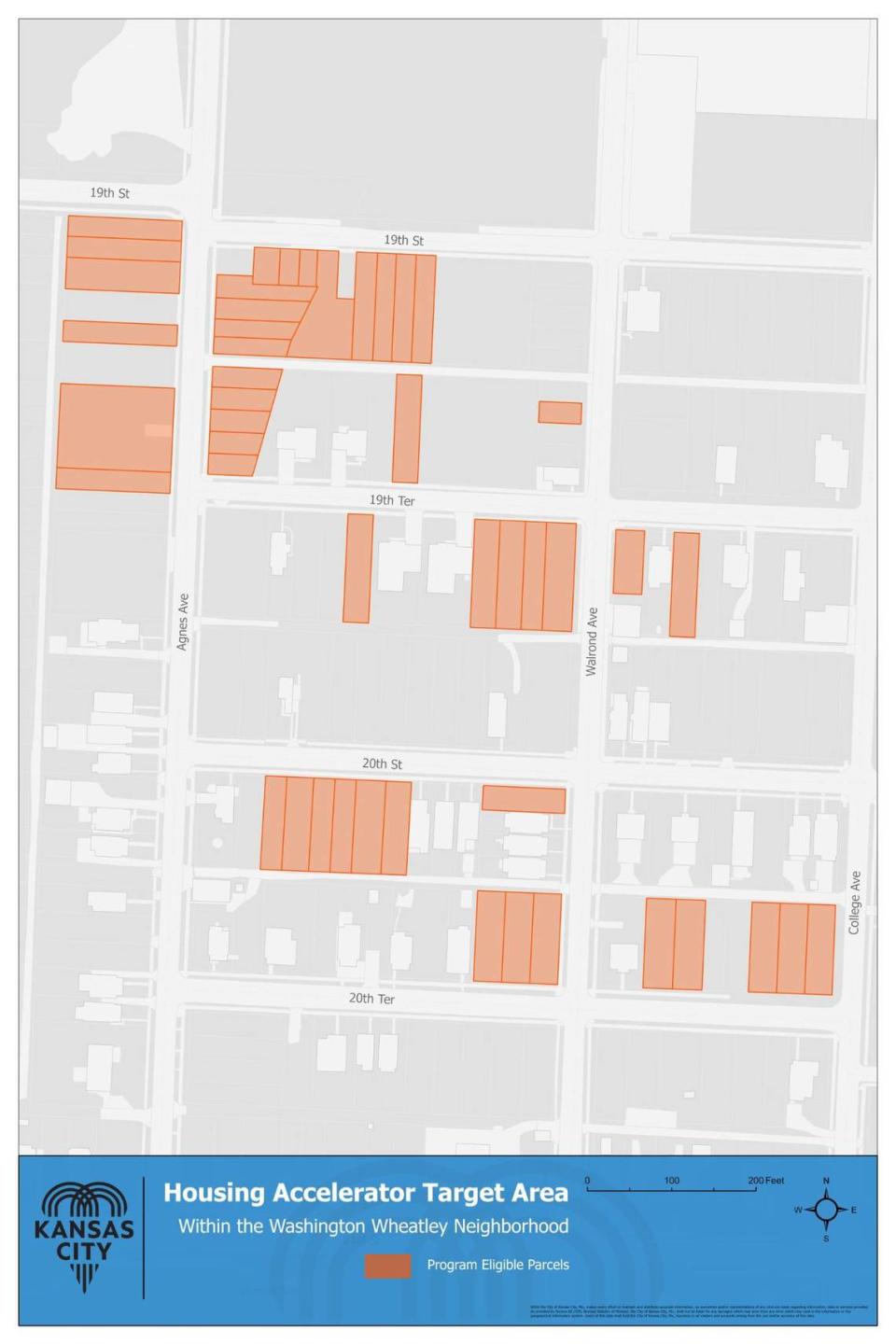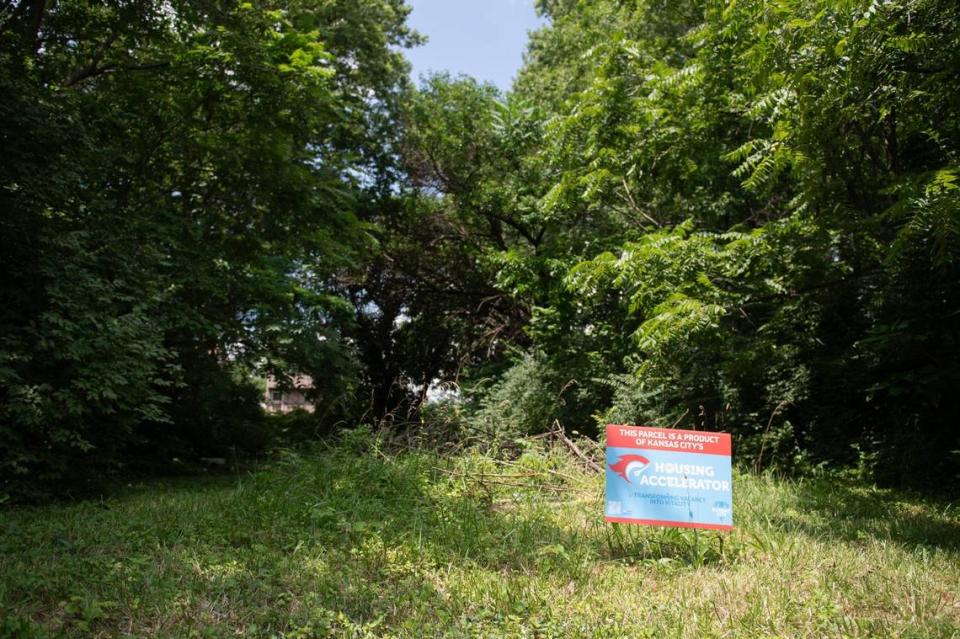House by house, a Kansas City neighborhood began to disappear. Can it be rebuilt?
From her tidy front porch, Patricia McCallop has watched her east Kansas City neighborhood disappear in slow motion over the half century she’s lived in the 2000 block of Agnes Avenue.
Most of the houses that were near hers when she and her late husband, Ed, moved there in the 1970s have been bulldozed one after another to the point that empty lots now outnumber the ones with houses on them.
“They were all houses,” McCallop, 79, says of the 95 acres of vacant lots to her north, east and south. On one block, only three houses stand where once there were 10 times that many. On another, 11 of the 16 lots are weed patches shaded by overgrown sucker trees.
“We need a lot of homes,” said McCallop, who is known around the neighborhood as simply Miss Pat. “We need to get those lots filled up for people where they can have a nice affordable home.”
One of Kansas City Councilwoman Melissa Patterson Hazley’s top priorities when she ran for office last year was to promote the construction of affordable houses on the thousands of vacant lots in underpopulated neighborhoods like McCallop’s.
The city has tried, and failed, to do as much through various programs over the years.
But Patterson Hazley hopes her new Housing Accelerator program does the trick where previous efforts out of City Hall have failed to make a noticeable dent. And if it does work as planned, she thinks McCallop and her neighbors will see noticeable change within a couple of years.
“I think that the city is committed to making some movement on the vacant lots,” Patterson Hazley said.
To demonstrate that commitment, the city’s Land Bank is practically giving land away at $201 a parcel in a six-square-block area in the Washington Wheatley neighborhood: a dollar for the land, plus $200 in processing fees.
Along with that steep discount, the city also promises to make it easier for developers to build single-family homes and duplexes on 47 Land Bank properties within that target area. Officials promise to cut government red tape in the permitting process, reduce developers’ legal costs by clearing real estate titles of past ownership claims and to arrange any needed utility line relocations.

‘A hot mess’ or ‘grand opportunity’?
While that might sound like a sweet deal, Patterson Hazley isn’t kidding herself. The environmental remediation many of those properties need can add uncertainty to the cost of each project. When the houses were torn down 30, 40 or even more years ago, demolition crews weren’t concerned with the toxic messes they left behind.
They merely knocked the house down, and what they didn’t haul to the dump they shoved into the basements and covered with dirt.
Dirt filled with traces of lead paint and asbestos that would need to be excavated for a new basement.
“The biggest challenge is environmental,” Patterson Hazley said. “We are guessing that there’s going to be significant lead abatement that needs to happen. And depending on how much soil they need to remove, that can exacerbate the costs.”
The city will cover the cost of testing for toxins in the soil and is exploring whether it can pay for the cleanup costs as well to make it more feasible for developers to build on those lots.
If this pilot is successful, then Patterson Hazley hopes the pattern can be replicated in other neighborhoods, bringing new life to the nearly 3,000 empty lots the city owns.
“It’s a hot mess, because there’s so many lots, but it’s also just a grand opportunity if you’re able to scale it,” she said.

Targeted for success?
Four days after she was sworn in Aug. 1 as the District 3 At-large representative, Patterson Hazley convened a dozen people in City Hall to brainstorm ways to best marry two key issues – the need for more affordable housing and rectifying the blight that the city-owned weedy, trash-strewn vacant lots inflicted on neighborhoods.
Architects, engineers, developers and neighborhood leaders joined subsequent meetings. The new pilot program is what they came up with.
Signs advertising the effort were planted on 47 vacant lots owned by the city’s Land Bank with the pilot project’s boundaries: 19th Street on the north, 20th Terrace on the south, Agnes on the west and College Avenue forms the east boundary.
The city picked the area because Washington Wheatley has a strong neighborhood association and enough vacant lots in one spot to make a large project feasible.
Neighbors told The Star the area feels safer these days than it used to and is ripe for change, within a couple of blocks of a resurgent Benton Boulevard.
It was different when Sharon Smith moved there in the early 2000s and bought a brand new house at a good price. She recalled abandoned houses that seemed to be hubs of illegal activity back then. .
“That’s been eliminated,” Smith said. “None of that goes on any more that I know.”
“It’s a lot better than it was,” she said. “It’s a nice, decent neighborhood now. I’ve got good neighbors.”
Deborah Murphy agrees.
“They have had big, positive change over the last 10-15 years,” she said. “Neighbors won’t tolerate it. Miss Pat? Un uh.”
Murphy lives a block to the south of Smith and catercorner from Miss Patt in a 920-square-foot house made out of steel shipping containers and surrounded by vacant lots, where other shipping-container homes were supposed to have been built several years ago.
But then the pandemic hit, and those plans changed about the time she was downsizing. First from a big house in the Kansas suburbs, to an apartment in the River Market.
“And this place popped up,” she said. It was a perfect size for her needs, close to downtown, and she likes that many of the people who live near her have family ties and look out for one another.
“You’ve got multi generations of family, cousins, aunties, nieces, nephews, granny. Four houses are all related, and they’ve been here for generations.”

‘An upward swing’
Vacant lots have been multiplying in the neighborhood for generations, as well.
Demolition permit information on the city’s property parcel search mapping system only goes back to the 1980s, but from what is available you can see the steady progression in what amounted to a neighborhood’s war of attrition against blight.
Of the houses that once stood on the 47 vacant lots in the target area, two fell in 1986, another in 1989, two in 1992 and so on every year or two until the most recent demolition in 2009.
A similar pattern repeated itself on the more than two dozen vacant lots in the area still under private ownership. Some of those owners are investors waiting for the best time to sell or develop, and land prices are on the rise, market watchers say.
Big, out-of-state real estate holding companies are buying houses, as well, in the city’s target area and turning them into rentals just like they’ve been doing all over eastern Kansas City.
Local fix-and-flip investors have renovated several houses in the target area and resold them to people who want to live in them rather than rent them out.
“There’s an upward swing,” said real estate agent Steele Chamberlain, who recently sold a house there for more than twice what Zillow said it was worth 10 years ago. “That neighborhood is going up, and investors are seeing that it’s going up.”
But the Housing Accelerator program isn’t aimed at increasing rental units on the East Side. Its goal is to increase the number of owner-occupied houses, thus building generational wealth within the predominantly Black community.
In its request for proposals from developers wanting to buy the dollar lots, the Land Bank made that a requirement:
“All housing shall be owner occupied,” it said. “Owners may sell property to other owners, but no housing shall become rental properties, including any multi-family units.”
The document does not say how that could be enforced. But the Land Bank often sells properties with claw back clauses based on the buyer meeting certain contingencies spelled out in the deed of trust.
The neighborhood association would also have the right to sign off on housing design, which must fit in with the existing housing stock. At minimum, each house or duplex must have two bedrooms and at least 1,000 square feet of living space.
The deadline for submitting applications was June 13. A team of city officials are evaluating proposals to see if they meet the standards and whether the developers have the financial wherewithal and experience to pull off their projects.
Not the city’s first try
The Land Bank’s past $1-a-lot and $1 house renovation specials have been flops.
Oftentimes, investors failed to build on the lots they bought from the agency. And often when developers did build new houses, the projects were scattershot, with a couple houses here and a couple there.
That approach made it hard to have an impact in any one specific neighborhood.
“People were doing onesies and twosies,” Patterson Hazley said. “When this person would do one or two on 12th Street and another person would do one or two on 27th Street, it’s hard to see change.”
If this program works, the change would be easy to see, and quickly she said, especially if one or two developers buy all 47 parcels – combining some of the smaller ones to form bigger lots – and build houses on them within the 18-month time frame they must agree to.
That would almost certainly cause more private investment in surrounding areas, Patterson Hazley said.
Miss Patt hopes it works. The Housing Accelerator project was all the talk, she said, at the June meeting of the Washington Wheatley Neighborhood Association, where she has long served as secretary treasurer. Some contractors were there and seemed eager to make connections.
“Something good’s gonna come out of it,” she said. “We’ve been on the back burner for the longest. So It’s time – it’s time.”


